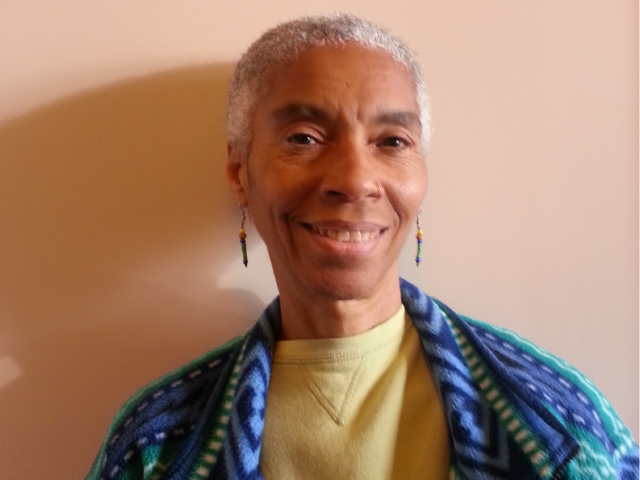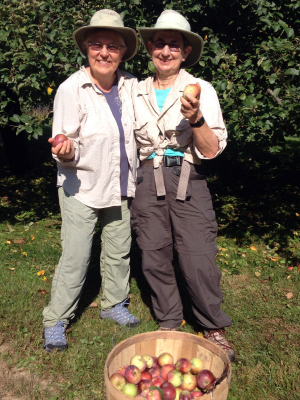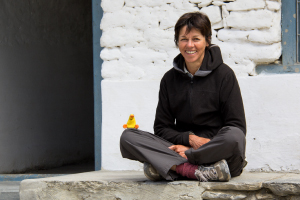Urban Contemplatives and Renunciation:
The Practice of Freedom in Lay Life
Written by: Tuere Sala

Rita Howard.
Photos by: Elinor Langan, Rae Levine, Tuere Sala , Peter Weertman.
(Editor’s note: This is the second of a two-part series by Tuere Sala about Northwest people and others who have made Buddhist practice the center of their lives, so much so that they live almost like monastics.
In this second installment Sala explores renunciation, what these people have let go of and what they’ve gained; and compassion, how this renunciation has opened their hearts to what Sala calls a “seamless integration with the difficulty of life,” an alignment with the suffering of others.)
Part one of this article discussed the lives and practices of five individuals, including myself, who live very different lives while practicing a similar underlying path.
All five of us share a contentment with the choices we have made in their lives. The contentment I saw in these people seemed to come from a willingness to focus one’s life around renunciation and compassion.

Ruby Phillips.
In an interview in the spring, 2007, issue of “Inquiring Mind” magazine, Monk Ajahn Amaro discussed the benefits of practicing renunciation.
Ajahn Amaro: When you relinquish control and take on the simplicity of the renunciate life, you have an opportunity to reflect on all the things to which you’ve become habituated. You take on restrictions in order to contact the most profound dimension of your own nature. There are no special meals or special rooms for special needs.
If you’re continually seeking comfort or trying to arrange the material world to meet your preferences, then you don’t notice those areas of bondage and attachment, and they remain barriers to accessing the fundamental unconditioned nature of the mind.
Inquiring Mind: In giving up the desire for control of your own life, you’re finding freedom.
Ajahn Amaro: Yes, and that’s practicing dharma in line with the dharma.
The Buddha says liberation is found in renunciation practice, so I asked each of the five people I interviewed what they had to “give up” or “renounce” to live an urban contemplative life. I learned that they were all willing to renounce anything that interfered with their practice.
As I listened to Rita Howard of Seattle, who has created a weekly sabbath day, I could sense how renunciation becomes natural when one makes spiritual practice a priority.
“Renouncing [driving, spending money, using electronics] once a week helps keep me in touch with how renunciation leads to liberation,” she said.

Jenn Biehn and Joan Lohman.
For Ruby Phillips, also of Seattle, liberation comes from giving up the concepts of “normal” and the “false sense of separation.”
“It is easy to give up whatever we are not attached to,” Philips said. “The difficulty is in seeing the attachments.”
For Devin Berry of the Bay Area, liberation came with giving up the need to have certain things in his life.
“I believed I had to have things,” he said. “I thought ‘I can’t live without this, or I can’t live without that,’ but gradually I realized that most of the things I thought I had to have were not essential for real happiness.”
And for Jenn Biehn and Joan Lohman of East Bay, renunciation meant giving up entertainment and “hanging out a lot,” changing the way they spend money, and what and how much they consume.
Although I had reflected upon renunciation as a necessary part of a spiritual practice, until the interviews I didn’t grasp just how important renunciation is to a contemplative life. I thought any type of contemplative life was primarily about practice and one’s commitment to practice.
However, in practicing the dharma in the midst of daily urban life, it is also important to be willing to let go of conveniences, even if just for little while. We live from one convenience to another, but once you start letting go of conveniences, you realize you can live without many things that others find important. Living a spiritual life takes on a new depth, when your practice becomes less and less distracted by the “conveniences” of life.
When I was reading for this article, I came across an essay written by Monk Bhikkhu Bodhi,entitled “The Balanced Way.” [ii] In it he said:
“[l]ike a bird in flight borne by its two wings, the practice of [dharma] is sustained by two contrasting qualities whose balanced development is essential to straight and steady progress. These two qualities are renunciation and compassion.
As a doctrine of renunciation the [dharma] points out that the path to liberation is a personal course of training that centers on the gradual control and mastery of desire, the root cause of suffering. As a teaching of compassion the [dharma] bids us to avoid harming others [and] to act for their welfare…”

Tuere Sala.
Compassion was the second aspect that stood out to me during these interviews with urban practitioners, and when I say compassion, I mean a seamless intimacy with the difficulty of life. This quality points to our willingness to work with the underlying tendencies of humans to cause harm, to ourselves or others. Compassion is a willingness to see into suffering, and to serve those who are suffering.
Readers’ response to part one of this article was very encouraging. It turns out there are quite a number of “urban contemplatives” living unique and creative lives.
Michelle Weertman, who lives in Bellevue, Washington, started living a contemplative life three years ago, after she first found meditation.
“It felt like my heart found a home with practice, and I was able to relax into it,” she said.
Weertman gave up busyness, projects, phones, computers and a lot of contact with people, in exchange for a quieter, more isolated life of contemplative practice. She says her daily meditation practice is fundamental.
“I practice for understanding,” she said. “When you understand fear you become fearless. When you understand grasping you become free.”
And how can we live a contemplative life in the middle of urban distractions?
“We live in an urban setting which means we need to practice with distractions, that is the nature of our real lives,” she said. “Learning to practice with distractions, not as distractions but as real life, is how we meet the practice while continuing to live our urban lives.”
I asked her if she found it difficult to live such an isolated life. Her response was quick and clear: “No.”
Once she saw that a lot of her busyness and entertainment was functioning as an avoidance, Weertman became disenchanted with them.
“It can be difficult to be around people because you lose the capacity to chit-chat and a large portion of conversation is based upon chit-chatting, which is mostly thought-based,” she said. “When you prioritize practice as your life, subjects become much deeper and more subtle, which does not make for chit-chat type conversations.”
The more I talked to people, the more I broadened my view of this depth of practice in daily life.

Michelle Weertman.
“We are living a third way,” said Melissa Page, who lives in Poulsbo, Washington. “Instead of thinking we’re going from lay life to monastic life, we are attempting to embody the two. The third way is about exploring how this works.”
About five years ago, Page began putting in motion her intention to live what she calls “the path of homelessness.”
She walked away from her job, her career and other conventional ways of living. She now rents out her house and lives off the generosity of others, offering volunteer time in exchange.
“I’m trying to find a way to live in the world but not of the world. It starts with being able to accept nothing is me…or mine,” Page said. “When you stop trying to make life happen a certain way and live with whatever comes up, you learn to live with impermanence and suffering.”
Page, who currently lives in a Christian community, helped start up a community garden, a community kitchen and a couple of meditation groups within that community. She follows the five precepts: Avoiding causing harm to living beings, taking only what is freely offered, avoiding the use of harsh, malicious, and false speech, avoiding sexual (and sensual) misconduct, and avoiding intoxicants.
She added the support of others is essential to walk this path.
“It really works when others see the value in living this way,” she said. “Being in a community is what allows you to live this way.”
I know there are many urban contemplatives, rural contemplatives, or simply contemplatives, living quiet lives in the modern world, and I know our practice and way of living doesn’t fit into some nice, neat box.
Wherever and whomever you are, I hope these two articles support your efforts to continue on your path and maybe open doors to greater community support. And if you are inspired by these articles to take up a contemplative life, consider these words from Bhikkhu Bodhi’s essay:
“For monk and householder alike, success in developing the path requires that both [renunciation and compassion] receive due attention, and that deficiencies in either gradually be remedied. Over time we will find that the two, though tending in different directions, eventually are mutually reinforcing.

Melissa Page.
Compassion impels us toward greater renunciation, as we see how our own greed and attachment make us a danger to others. And renunciation impels us toward greater compassion, since the relinquishing of craving enables us to exchange the narrow perspectives of the ego for the wider perspectives of a mind of boundless sympathy.
Held together in this mutually strengthening tension, renunciation and compassion contribute to the wholesome balance of the Buddhist path and to the completeness of its final fruit.”[iii]
Whether you choose to enter this path through cultivating compassion and service, or renouncing your added attachments, prioritizing your practice is the first step onto the path of contemplative living.
[i] The Bottom Line: Dharma in Line with the Dharma, an interview with Ajahn Amaro appearing in Spring 2007 issue of Inquiring Mind.
[ii] The Balanced Way, by Bhikkhu Bodhi, Access to Insight (Legacy Edition), 2 June 2010, http://www.accesstoinsight.org/lib/authors/bodhi/bps-essay_08.html
[iii] Id.
